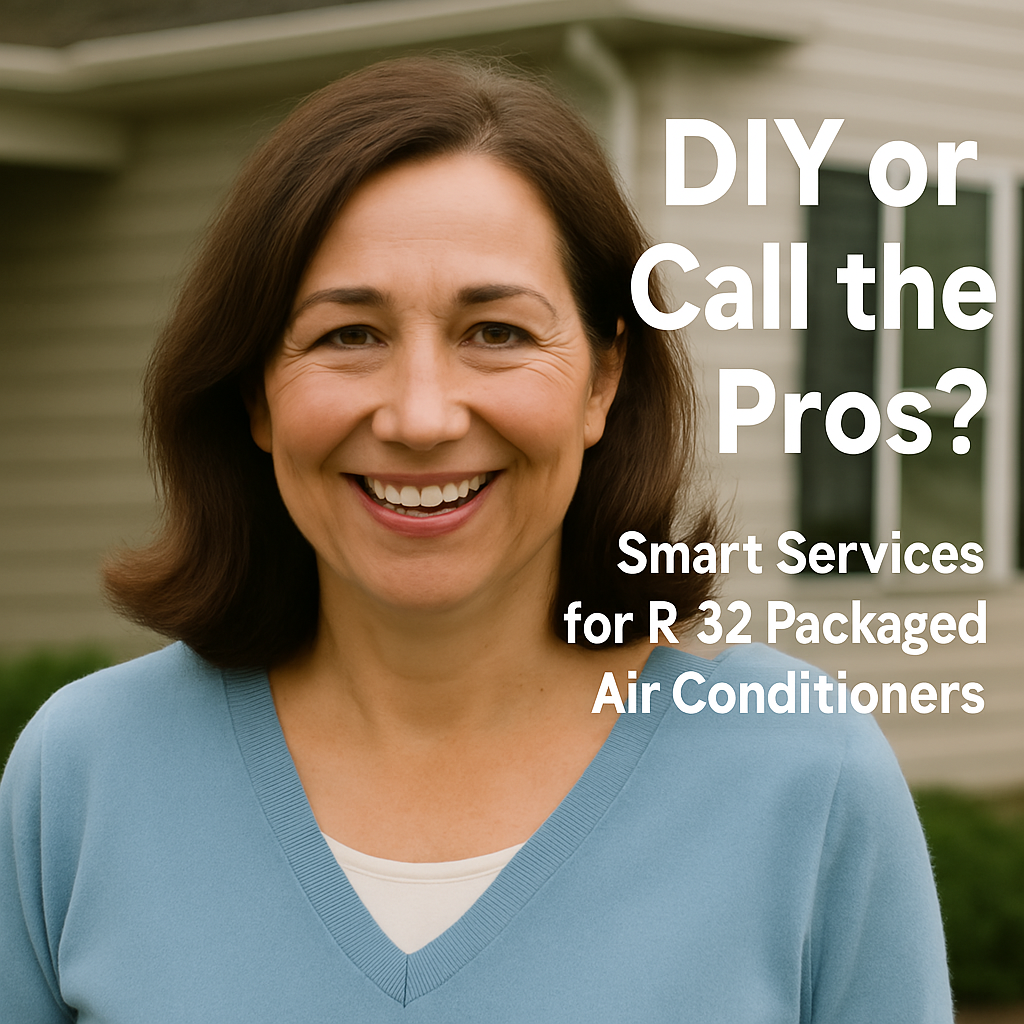👋 Hey There, from Samantha
Hello again, savvy homeowners and smart-watchers—Samantha here! You’ve got an R‑32 packaged AC, and that’s already something to be proud of. But now the big question: should you try to handle maintenance or repairs yourself—or call in a pro?
This blog walks you through exactly which tasks are safe (and helpful) to DIY, and which ones cross into technician-only territory, especially given the flammable A2L classification of R‑32. Let’s figure it out together so your system stays safe, efficient, and worry-free. 😊
1️⃣ Why This Matters for Packaged ACs
Unlike split systems, packaged AC units combine all heating, cooling, and controls in one outdoor appliance. That means:
-
All critical components—compressor, coils, refrigerant lines—live outside.
-
Service zones are exposed to weather, pets, decay, and debris.
-
Tasks like refrigerant retrieval and pressure testing are intertwined, making DIY a fine line between “clever” and “catastrophe.”
R‑32’s A2L rating intensifies that dynamic—making clear boundaries vital.
2️⃣ Safe DIY Tasks for Homeowners
Here are maintenance tasks you can safely tackle (with guidance):
🔄 Filter Changes
-
Recommended every 2–3 months—or monthly in heavy-use seasons.
-
Shut unit off first—always turn power breaker off before accessing panels.
-
Clean or replace filters: vacuum washable types or swap standard ones.
➡️ Example video walkthrough: ENERGY STAR filter guide.
💦 Coil and Drain Pan Cleaning
-
Use gentle coil cleaner on evaporator fins (in-packaged units, these are accessible behind panels).
-
Clear debris to prevent water backup.
-
Flush condensate pan with bleach-vinegar solution.
Reference: DOE HVAC maintenance tips.
🧰 Visual & Performance Checks
-
Inspect cabinet seams, seal strips, and fan shroud for damage.
-
Listen for unusual sounds: rattles, humming, loose fan blades.
-
Monitor thermostat response, check airflow—possibly invest in a $20 digital thermometer.
3️⃣ Tasks That Require a Pro (and Why)
Certain jobs require specialized training, tools, and certification:
⚠️ Refrigerant Handling
-
EPA Section 608 certification required, and not optional.
-
Only a licensed pro with A2L-trained certification should handle R‑32 regassing, leak detection with nitrogen, charging, and recovery.
-
According to the U.S. Environmental Protection Agency’s guidelines on refrigerants, it’s illegal to purchase or handle these substances without proper credentials.
🔬 Leak Testing & Pressure Checks
-
DIY solutions like soap bubbles won’t cut it—and could be hazardous.
-
Accurate leak detection with sniffer tools and vacuum testing is a certified technician task.
🛠️ Compressor or Control Board Replacement
-
Requires refrigerant recovery, partial charge discharge, potentially brazing piping—beyond DIY safety.
-
Electrical controls tied to NEC rules. Professionals must ensure compliance.
🌬️ Fan Motor & Capacitor Repair
-
Safe only when the unit is fully isolated and properly discharged.
-
Miswired caps or fans can cause fire or damage.
4️⃣ Your DIY-Pro Spectrum: A Clear Workflow
Here’s a simple checklist to help homeowners decide:
| Task | DIY Safe? | Notes |
|---|---|---|
| Filter replacement | ✅ | Always shut off breaker |
| Coil & drain clean | ✅ | Wear gloves, avoid PCB cleaners |
| Cabinet/rust repair | ✅ | Reseal with silicone caulk |
| Thermostat battery swap | ✅ | Safe, but avoid rewiring |
| Performance inspection | ✅ | Monitor temps, airflow |
| Leak detection | ❌ | Needs Licensed tech |
| Refrigerant charging | ❌ | Illegal without certification |
| Compressor replacements | ❌ | Risky & complex |
| Electrical repairs | ❌ | Requires licensed electrician |
5️⃣ When to Call the Pros (And What to Expect)
📅 Annual Tune-Up
A pro check-up includes:
-
Confirming proper refrigerant pressure (superheat/subcool).
-
Leak testing under nitrogen.
-
Electrical inspection: breakers, wiring, control voltages.
-
Coil inspection, lubrication, drain and airflow check.
A full tune-up takes about 90 minutes, usually costing $150–300.
Not sure what a thorough tune-up involves? The ACCA’s HVAC maintenance checklist gives a solid breakdown of what pro-grade seasonal care should look like.
🚨 Emergency Repairs
If you notice:
-
Hissing, frosted lines, or lack of cooling.
-
Power issues, buzzing, vibrations.
-
Leaks or water damage around the unit.
Call in emergency R‑32–certified techs—they’ll bring leak detection gear, recovery equipment, safe tools, and insurance.
6️⃣ Cost Comparison: DIY vs Pro
-
DIY Annual Care: Filters + coil cleaner = ~$50.
-
Professional Tune-Up: $150–300/year.
-
Major Repair (compressor): $1,200–2,500 installed.
-
Refrigerant recharge (R‑32): ~$150–$300
-
Leak diagnostics: variable—often $200+.
Pro tip: A $1,200 compressor + $200 diagnostic = $1,400. If a $300 tune-up prevents one major failure—or extends compressor life—DIY could cost more in the long run.
7️⃣ Pro Tips for Homeowners
-
Document all DIY work: photos, dates, used parts.
-
Create a maintenance calendar—filter, clean, inspect every quarter.
-
Keep warranty paperwork handy—invalidate if you tamper with critical components.
-
Hire reputable pros—check EPA certification and ask specifically about R‑32 / A2L licenses.
-
Ask your tech for a digital service report—including pressure readings and refrigerant weight.
🌸 Wrap-Up from Samantha
Owning an R‑32 packaged AC is smart—but maintaining it safely means knowing your limits. DIYing basics like filters, coil cleaning, and inspections saves money, but for refrigerant, leak testing, repairs, or replacements? Leave it to the trained professionals. They’ve got the tools, knowledge, and legal certifications to handle it right.
When you're ready to explore the latest models designed for optimal service and safety, check out the full R‑32 Residential Packaged Air Conditioners collection at The Furnace Outlet.
Need to know if your refrigerant is charged right? Browse my guide Smart Pressure Profiles: How to Diagnose R‑32 Refrigerant Levels in Packaged AC Units.
Stay smart, stay safe—whether you're doing it yourself or calling in the pros.
—Samantha 🛠️







